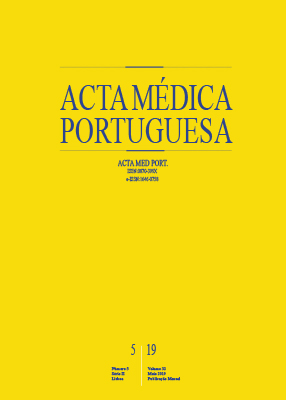Late-Night Salivary Cortisol: Cut-Off Definition and Diagnostic Accuracy for Cushing’s Syndrome in a Portuguese Population
DOI:
https://doi.org/10.20344/amp.11265Keywords:
Circadian Rhythm, Cushing Syndrome/diagnosis, Diagnostic Techniques, Endocrine, Hydrocortisone, SalivaAbstract
Introduction: Diagnosis of Cushing’s syndrome remains a challenge in clinical endocrinology. Even though late-night salivary cortisol is used as screening tool, individualized cut-off levels for each population must be defined.
Material and Methods: Three groups of subjects were studied: normal subjects, suspected and proven Cushing’s syndrome. Salivary cortisol was measured using an automated electrochemiluminescence assay. The functional sensitivity of the assay is 0.018 μg/dL. The diagnostic cut-off level was defined by Receiver Operating Characteristic curve and Youden’s J index.
Results: We studied 127 subjects: 57 healthy volunteers, 39 patients with suspected and 31 with proven Cushing’s syndrome. 2.5th - 97.5th percentile of the late-night salivary cortisol concentrations in normal subjects was 0.054 to 0.1827 μg/dL. Receiver Operating Characteristic curve analysis showed an area under the curve of 0.9881 (p < 0.0001). A cut-off point of 0.1 μg/dL provided a sensitivity of 96.77% (95% CI 83.3 - 99.92%) and specificity of 91.23% (95% CI 80.7 - 97.09%). There was a significant correlation between latenight salivary cortisol and late-night serum cortisol (R = 0.6977; p < 0.0001) and urinary free cortisol (R = 0.5404; p = 0.0025) in proven Cushing’s syndrome group.
Discussion: The mean ± SD late-night salivary cortisol concentration in patients with proven Cushing’s syndrome (0.6798 ± 0.52 μg/ dL) was significantly higher (p < 0.0001). In our population, the late-night salivary cortisol cut-off was 0.1 μg/dL with high sensitivity and specificity.
Conclusion: Late-night salivary cortisol has excellent diagnostic accuracy, making it a highly reliable, noninvasive, screening tool for outpatient assessment. Given its convenience and diagnostic accuracy, late-night salivary cortisol may be added to other traditional screening tests on hypercortisolism.
Downloads
Downloads
Published
How to Cite
Issue
Section
License
All the articles published in the AMP are open access and comply with the requirements of funding agencies or academic institutions. The AMP is governed by the terms of the Creative Commons ‘Attribution – Non-Commercial Use - (CC-BY-NC)’ license, regarding the use by third parties.
It is the author’s responsibility to obtain approval for the reproduction of figures, tables, etc. from other publications.
Upon acceptance of an article for publication, the authors will be asked to complete the ICMJE “Copyright Liability and Copyright Sharing Statement “(http://www.actamedicaportuguesa.com/info/AMP-NormasPublicacao.pdf) and the “Declaration of Potential Conflicts of Interest” (http:// www.icmje.org/conflicts-of-interest). An e-mail will be sent to the corresponding author to acknowledge receipt of the manuscript.
After publication, the authors are authorised to make their articles available in repositories of their institutions of origin, as long as they always mention where they were published and according to the Creative Commons license.









